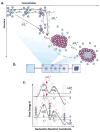Biomineralization mechanisms: a new paradigm for crystal nucleation in organic matrices
- PMID: 23241924
- PMCID: PMC3726565
- DOI: 10.1007/s00223-012-9678-2
Biomineralization mechanisms: a new paradigm for crystal nucleation in organic matrices
Abstract
There is substantial practical interest in the mechanism by which the carbonated apatite of bone mineral can be initiated specifically in a matrix. The current literature is replete with studies aimed at mimicking the properties of vertebrate bone, teeth, and other hard tissues by creating organic matrices that can be mineralized in vitro and either functionally substitute for bone on a permanent basis or serve as a temporary structure that can be replaced by normal remodeling processes. A key element in this is mineralization of an implant with the matrix and mineral arranged in the proper orientations and relationships. This review examines the pathway to crystallization from a supersaturated calcium phosphate solution in vitro, focusing on the basic mechanistic questions concerning mineral nucleation and growth. Since bone and dentin mineral forms within collagenous matrices, we consider how the in vitro crystallization mechanisms might or might not be applicable to understanding the in vivo processes of biomineralization in bone and dentin. We propose that the pathway to crystallization from the calcium phosphate-supersaturated tissue fluids involves the formation of a dense liquid phase of first-layer bound-water hydrated calcium and phosphate ions in which the crystallization is nucleated. SIBLING proteins and their in vitro analogs, such as polyaspartic acids, have similar dense liquid first-layer bound-water surfaces which interact with the dense liquid calcium phosphate nucleation clusters and modulate the rate of crystallization within the bone and dentin collagen fibril matrix.
Conflict of interest statement
The authors have stated that they have no conflict of interest.
Figures




Similar articles
-
Aspects of collagen mineralization in hard tissue formation.Int Rev Cytol. 2005;242:121-56. doi: 10.1016/S0074-7696(04)42003-8. Int Rev Cytol. 2005. PMID: 15598468 Review.
-
Water in the formation of biogenic minerals: peeling away the hydration layers.J Struct Biol. 2013 Aug;183(2):278-303. doi: 10.1016/j.jsb.2013.06.007. Epub 2013 Jun 19. J Struct Biol. 2013. PMID: 23791831 Free PMC article.
-
Refinement of collagen-mineral interaction: a possible role for osteocalcin in apatite crystal nucleation, growth and development.Bone. 2015 Feb;71:7-16. doi: 10.1016/j.bone.2014.09.021. Epub 2014 Oct 2. Bone. 2015. PMID: 25284158
-
In vitro models of collagen biomineralization.J Struct Biol. 2013 Aug;183(2):258-69. doi: 10.1016/j.jsb.2013.04.003. Epub 2013 Apr 15. J Struct Biol. 2013. PMID: 23597833 Review.
-
Structural relationship between the primary crystal formations and the matrix macromolecules in different hard tissues. Discussion of a general principle.Connect Tissue Res. 1995;33(1-3):171-8. doi: 10.3109/03008209509016998. Connect Tissue Res. 1995. PMID: 7554950 Review.
Cited by
-
Fluorescence evidence of annexin A6 translocation across membrane in model matrix vesicles during apatite formation.J Extracell Biol. 2022 Apr 20;1(4):e38. doi: 10.1002/jex2.38. eCollection 2022 Apr. J Extracell Biol. 2022. PMID: 38939118 Free PMC article.
-
Mineralization of Biomaterials for Bone Tissue Engineering.Bioengineering (Basel). 2020 Oct 20;7(4):132. doi: 10.3390/bioengineering7040132. Bioengineering (Basel). 2020. PMID: 33092121 Free PMC article. Review.
-
Disentangling the Amyloid Pathways: A Mechanistic Approach to Etiology.Front Neurosci. 2020 Apr 21;14:256. doi: 10.3389/fnins.2020.00256. eCollection 2020. Front Neurosci. 2020. PMID: 32372895 Free PMC article.
-
In vivo Regeneration of Mineralized Bone Tissue in Anisotropic Biomimetic Sponges.Front Bioeng Biotechnol. 2020 Jul 7;8:587. doi: 10.3389/fbioe.2020.00587. eCollection 2020. Front Bioeng Biotechnol. 2020. PMID: 32775319 Free PMC article.
-
Effects of mineralization on the hierarchical organization of collagen-a synchrotron X-ray scattering and polarized second harmonic generation study.Interface Focus. 2024 Jun 7;14(3):20230046. doi: 10.1098/rsfs.2023.0046. eCollection 2024 Jun. Interface Focus. 2024. PMID: 39081623 Free PMC article.
References
-
- Veis A. Mineralization in organic matrix frameworks. In: Dove PM, DeYoreo JJ, Weiner S, editors. Biomineralization. Vol. 54. 2003. pp. 249–289. Reviews in Mineralogy & Geochemistry.
-
- Landis WJ, Song MJ, Leith A, McEwen L, McEwen B. Mineral and organic matrix interaction in normally calcifying tendon visualized in three dimensions by high voltage electron microscopic tomography and graphic image reconstruction. Journal of Structural Biology. 1993;110:39–54. - PubMed
-
- Orgel JPRO, San Antonio JD, Antipova O. Molecular and structural mapping of collagen fibril interactions. Connect Tissue Research. 2011;52:2–17. - PubMed
-
- Silver FH, Landis WJ. Deposition of apatite in mineralizing vertebrate extracellular matrices: A model of possible nucleation sites on type I collagen. Connect Tissue Research. 2011;52:242–254. - PubMed
-
- Wang Y, Azaïs T, Robin M, Vallée A, Catania C, Legriel P, Pehau-Arnaudet G, Babonneau F, Giraud-Guille M-M, Nassif N. The predominant role of collagen in the nucleation, growth, structure and orientation of bone apatite. Nature Materials. 2012;11:724–733. - PubMed
Publication types
MeSH terms
Substances
Grants and funding
LinkOut - more resources
Full Text Sources
Other Literature Sources

